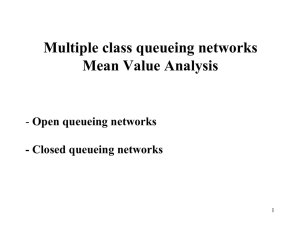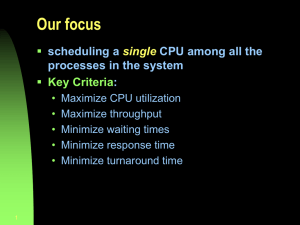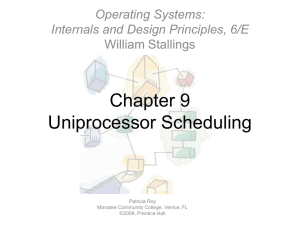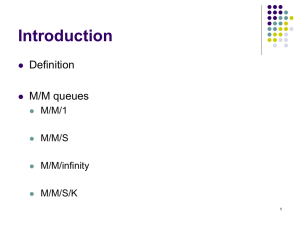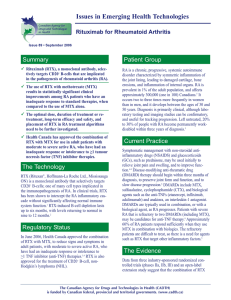RL_RTX_scheduler
advertisement
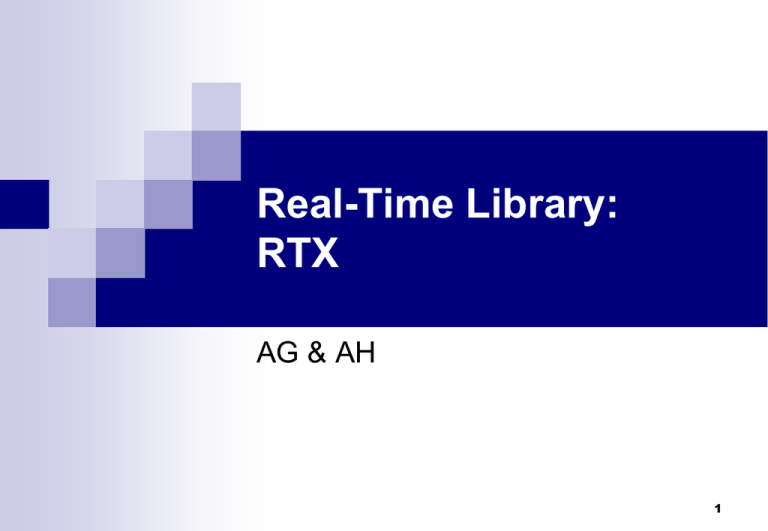
Real-Time Library:
RTX
AG & AH
1
What is an RTOS?
An RTOS is a special version of an operating system that
provides a more deterministic behaviour for the tasks under its
control.
At its core is a Real-Time Executive(RTX).
The RTX provides the primitives to
Create, Manage and Schedule tasks
Manage and use time in controlling tasks
allow inter-task communication through:
semaphores
mutexes
events
mailboxes
4-2
What is a Task?
For our purposes we can consider a task to be a basic unit of
programming that the operating system controls.
Our tasks will be written in 'C' and be of the form of an
endless while(1) loop.
We will use a simple RTX to create and manage our tasks.
Our application programs will consist of a number of tasks
which are controlled by the RTX and that communicate with
each other using some of the RTX features. Covered later!
void task1(void)
{
while(1)
{
// do task 1
}
void task2(void)
{
while(1)
{
// do task 2
}
void task3(void)
{
while(1)
{
// do task 3
}
}
}
}
4-3
The Scheduler
At the Kernel of the RTX is the scheduler
Responsible for allocating CPU time to the tasks.
A hardware timer provides a basic "tick" to measure time. "tick" time is
configurable and affects responsiveness of the system. Default RTX
tick time is 10ms.
This scheduler is essentially a timer interrupt that allots a
certain amount of execution time to each task. So task1 may
run for 100ms then be de-scheduled to allow task2 to run for
a similar period; task 2 will give way to task3, and finally
control passes back to task1.
By allocating these slices of runtime to each task in a roundrobin fashion, we get the appearance of all three tasks
running in parallel to each other.
4-4
The Scheduler
In order to make the task-switching process happen,
we have the code overhead of the RTOS and we
have to dedicate a CPU hardware timer to provide
the RTOS time reference.
For ARM7 and ARM9 this must be a timer provided
by the microcontroller peripherals.
In a Cortex-M microcontroller, RTX will use the
SysTick timer within the Cortex-M processor.
4-5
The Scheduler
Each time we switch running tasks the RTOS saves
the state of all the task variables to a task stack and
stores the runtime information about a task in a Task
Control Block.
The “context switch time”, that is, the time to save
the current task state and load up and start the next
task, is a crucial value and will depend on both the
RTOS kernel and the design of the underlying
hardware.
4-6
Task states
A task can be in one of four basic states, RUNNING,
READY, WAITING, or INACTIVE.
In a given system only one task can be running, that
is, the CPU is executing its instructions while all the
other tasks are suspended in one of the other states
If, during our RTOS program, there is no task
running and no task ready to run (e.g. they are all
waiting on delay functions), then RTX uses the spare
runtime to call an “Idle Demon
4-7
Simple Round Robin Scheduler
All tasks have the same priority and tasks run in turn
on the CPU for a given number of "time quanta" or
"ticks".
CPU
Task at front of queue
selected to run
Ready Queue
of tasks.
8
The
running
task
Round Robin
time out. Task
put on end of
ready queue.
Example with three tasks T1, T2 and T3
Each task runs for the Round Robin time.
Running
task
T1
T2
T3
T1
T2
T3
T1
Time
9
etc.
Round Robin with task waiting queues
Task at front of queue
selected to run
Typically a running task often
has to wait for some resource
therefore is removed from the
CPU and is placed in a
queue.
CPU
The
running
task
Round Robin
time out
Queue of ready to
run tasks
NB. There is a system task
called os_idle_demon that runs
when there are no tasks in the
ready queue.
10
Tasks waiting
for mutex,
semaphore or
mailbox
Tasks waiting
for event(s)
Tasks becomes ready and
rejoin queue of ready tasks
Delayed and
periodic
tasks
Example with three tasks T1, T2 and T3
T1 execution time is 50ms then delays for 180ms
second,T2 and T3 never delay and the round robin
time is 50ms. Assume ready queue is T1,T2,T3.
T1
T2
T3
T2
T3
T2
T1
T3
T2
Time ms
0
50
100
150
200
250
300
350
T1 delays for 180ms
T1 delays itself for
180ms
11
T1 now joins
ready queue, at
time 230ms.
T1run after T2.
Remember it
joins the end of
the queue.
Round Robin with Priority scheduling
Highest priority task is selected
when CPU free.
Queue of ready
Tasks queue
sorted into priority
order
12
CPU
Running task doesn't
need to run for a certain
time so relinquishes the
CPU.
The
running
task
Round Robin
time up
Tasks waiting
for mutex,
semaphore or
mailbox
Tasks waiting
for event(s)
Tasks becomes ready and
rejoin queue of ready tasks
Delayed and
periodic
tasks
Round Robin with Priority Scheduling
E.g.Three tasks T1, T2 with priority 4 in the ready
queue and T3 with priority 6 is in a waiting queue.T3 is
an event driven task that executes in 30ms.
T1
T2
T1
T3
T2
T1
T2
T1
Time ms
0
50
100
Time 125ms:
T3 becomes ready
and joins ready
queue.
13
150
200
Time 150ms:
T3 now runs
because highest
priority ready
task.
250
300
350
Time 180ms:
T3 runs for 30ms then
relinquishes CPU and joins a
waiting queue again. Scheduler
runs next task from the ready
queue.
Round Robin Priority scheduling
with pre-emption.
Pre-empt running task if a higher
priority task is ready.
Highest priority task is selected
when CPU free.
Queue of ready
Tasks queue
sorted into priority
order
CPU
Running task doesn't
need to run for a certain
time so relinquishes the
CPU.
The
running
task
Round Robin
time up
Tasks waiting
for mutex,
semaphore or
mailbox
Tasks waiting
for event(s)
Tasks becomes ready and
rejoin queue of ready tasks
14
Delayed and
periodic
tasks
Round Robin Priority scheduling
with pre-emption.
E.g.Tasks T1, T2 with priority 4 both in the ready
queue and T3 with priority 6 is in a waiting queue.
6 Priority
5
4
T3
T1
T2
T1
T1
T2
T1
T2
T1
Time ms
0
50
100
150
Time 125ms:
T3 becomes ready and
immediately pre-empts the
currently running task. because
it is higher priority.
15
200
250
300
350
Time 155ms:
T3 runs for 30ms then relinquishes
the CPU and joins a waiting queue
again. Pre-empted T1 is restarted
and runs for the rest of its round robin
time - assuming it is still the highest
priority.
The ARM RL-RTX
We will be using a Real Time eXecutive with the
ARM based board Keil MCB 2300
To use the RTX the file RTL.h must
be included in the 'C' source file
and the operating system project
option set to use the RTX Kernel.
There are 35 RTX related functions
providing facilities for:
16
task creation and management
time management
events
mutexes
semaphores
mailboxes
#include <RTL.h>
The RTX Scheduler - Timer Tick Interrupt
17
The RTX kernel for ARM7™ uses one of the standard
ARM timers to generate a periodic interrupt.
This interrupt is called the RTX kernel timer tick. For
some of the RTX library functions, you must specify
timeouts and delay intervals as a number of RTX
kernel timer ticks.
The parameters for the RTX kernel timer are
selected in the RTC_Config.c configuration file.
For example, the RTX_Config.c file for NXP
LPC23XX use Timer 0, 1,2 or 3 for the RTX kernel
timer.
RTX_Config.c
The timer clock value
specifies the input clock
frequency and depends on
CPU clock and APB clock. For
a device with CPU clock 48
MHz and VPB divider 4 the
peripheral clock is 12MHz and
therefore the value is set to
12000000.
The time tick value specifies the interval of the periodic RTX
interrupt. The value 10000 us configures timer tick period of 0.01
seconds.
18
Starting the OS and Task Creation
Start the OS and creating the first task with a default priority of 1.
void os_sys_init(task_name);
os_sys_init (begin); // start os then start task begin
Create tasks
OS_TID os_task_create(task_name, priority);
t1_ID = os_tsk_create (task1, 4);
t2_ID = os_tsk_create (task2, 6);
t1_ID and t2_ID must have been declare globals in the
program :
19
OS_TID t1_ID, t2_TID;
Task Creation
Start the OS and create the initial task.
void os_sys_init(task_name); /* priority defaults to 1
os_sys_init (begin); // start os then start task begin
To create further tasks the initial task uses:
OS_TID os_task_create(task_name, priority);
Example
OS_TID t1_ID; // define a task ID variable
// now create the task
t1_ID = os_task_create (task1, 4);
priority is from 1 to 255. 1 being the lowest priority.
Beware: If task1 is now the highest priority it will pre-empt
the current task!!
20
Tasks are basically 'C' functions with the special attribute __task added
before the function definition.
Other Task Management Functions
os_tsk_delete - Terminates a selected task
–
os_tsk_delete_self
-Terminates the running task
os_tsk_self - Returns the task ID of the running task
os_tsk_pass - Passes control to the next task ready to run
os_tsk_prio - Changes the priority of a given task
os_tsk_prio_self - Changes the priority of the running task
21
Typical task
A task is nothing more than a 'C' function.
The task will usually be in the form of an endless
while loop that never terminates.
Many tasks are periodic E.g.
__task void mytask(void)
{ /* create variables for this task */
while(1)
{
/* do stuff */
os_dly_wait(100); /* periodic - so have a rest */
}
}
22
Time Management functions
void os_dly_wait(n_ticks)
Pauses the –calling task for a specified interval.
void os_itv_set(n_ticks)
Enables the calling task for periodic wake up.
void os_itv_wait(n_ticks)
Pauses the calling task until the periodic wake up interval expires.
Examples
FIO2SET = LED_A;
os_dly_wait(10);
FIO2CLR = LED_A;
23
void task1 (void) __task {
os_itv_set(20);
while(1)
{
FIO2PIN ^= LED_A; // toggle led
os_itv_wait();
}
}
Event Flag Management functions
Used to provide very simple inter-task signalling.
os_evt_clr Clears one or more event flags of a task.
os_evt_get Retrieves the event flags that caused
os_evt_wait_or to complete.
os_evt_set Sets one or more event flags of a task.
os_evt_wait_and Waits for one or more event flags to be set.
os_evt_wait_or Waits for any one event flag to be set.
isr_evt_set Sets one or more event flags of a task.
24
Better inter-task communication methods are
available - coming soon!
RTX Based Program Operation
'C' main function should Start OS and first task.
First task will: initialise
system ready for other tasks
initialise I/O
create and initialise global systems feature such as :
mutexes
semaphores
filesystems
etc
Start
the other tasks
Terminate self
25
Now other tasks run & operate concurrently.
A first example - RTX01.c
Before any of the RTX functions can be used the
RTX must be started.
os_sys_init (taskname);
This function initialises and starts the RTX and then
starts the taskname task.
The initial task is given the default priority of 1
NOTES:
The
os_sys_init function must be called from the main C
function.
The os_sys_init function NEVER returns!
26
Starting the OS and the application tasks.
#include <RTL.h>
/*
...
*/
OS_TID t1_ID, t2_ID, t3_ID; /* create task IDs */
int main (void)
{
uint32_t volatile start;
/* Wait for debugger connection */
for (start = 0; start < 1000000; start++) { ; }
os_sys_init (begin);/* Initialize OS and start the initial task */
}
__task void begin (void)
{
os_tsk_prio_self(10); /* increase priority of this task */
/* initialise system peripherals etc. here */
t1_ID = os_tsk_create (task1, 4); /* start task1 */
t2_ID = os_tsk_create (task2, 2); /* start task2 */
t3_ID = os_tsk_create (task3, 1); /* start task3 */
os_tsk_delete_self ();
}
27
